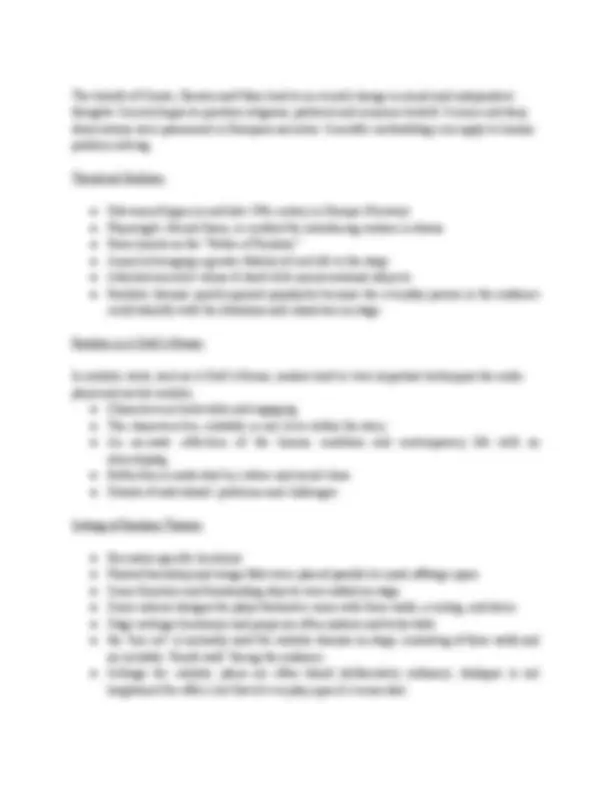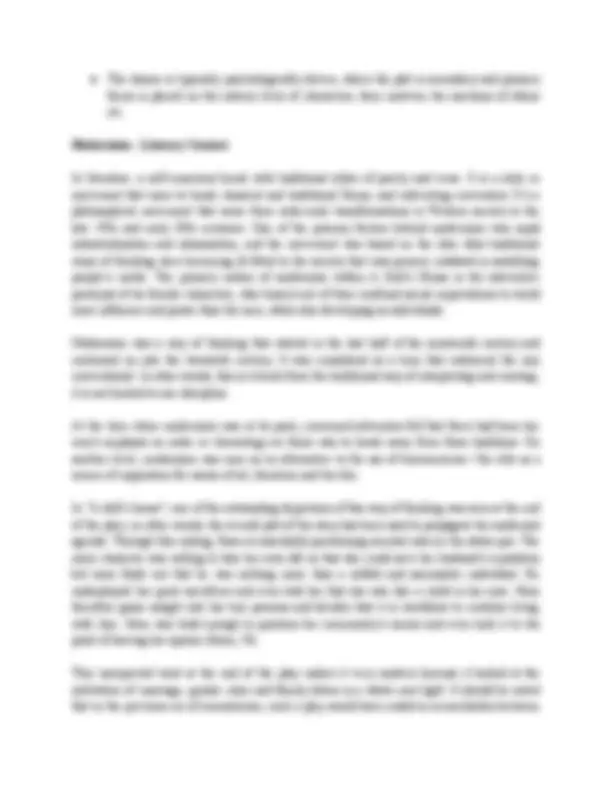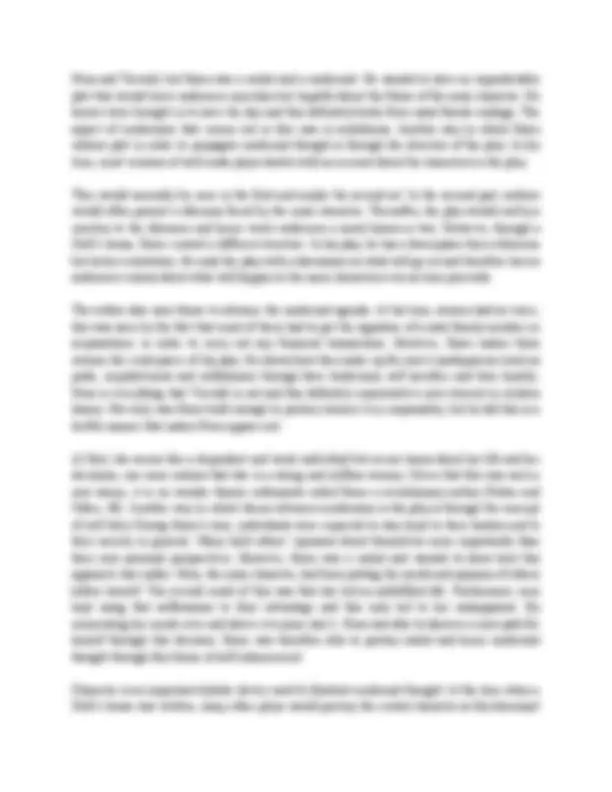






Study with the several resources on Docsity

Earn points by helping other students or get them with a premium plan


Prepare for your exams
Study with the several resources on Docsity

Earn points to download
Earn points by helping other students or get them with a premium plan
Community
Ask the community for help and clear up your study doubts
Discover the best universities in your country according to Docsity users
Free resources
Download our free guides on studying techniques, anxiety management strategies, and thesis advice from Docsity tutors
Henrik Ibsen - Personal Context. Henrik Ibsen was born into a wealthy family in Skien, Norway. His father, a merchant, was successful early on in life, ...
Typology: Schemes and Mind Maps
1 / 8

This page cannot be seen from the preview
Don't miss anything!





Henrik Ibsen - Personal Context Henrik Ibsen was born into a wealthy family in Skien, Norway. His father, a merchant, was successful early on in life, but when Ibsen was seven his father's business suffered a great financial loss. This caused Ibsen’s father to become jaded and an alcoholic; he took out his troubles on his children and wife, who Ibsen’s sister described as loving and self-sacrificing. Ibsen began writing plays at the age of fifteen; he did not pass the entrance exams to university, but decided he would rather focus on writing anyway. He was at first a very unsuccessful playwright, and he and his wife Suzannah Thoresen were extremely poor. In 1864 he left Thoresen and their five-year-old son, Sigurd (who grew up to become the Prime Minister of Norway, and moved to Sorrento, Italy. He later moved to Dresden, Germany (where he wrote A Doll’s House), not returning to Norway until 1891. After his initial unsuccessful years, Ibsen became more popular as a writer, although his plays were considered to be very scandalous. He died in Oslo in 1906, after suffering several strokes. He is now one of the world’s most famous playwrights, and his work is performed more often than that of any other playwright except Shakespeare. He is often considered to be “the father of realism” in drama, and is also thought of as a pioneer of Modernism. Realism - Literary Context Realism in the theatre was a general movement that began in the 19th-century theatre, around the 1870s, and remained present through much of the 20th century. It developed a set of dramatic and theatrical conventions with the aim of bringing a greater fidelity of real life to texts and performances. Part of a broader artistic movement, it includes Naturalism and Socialist realism. Russia's first professional playwright, Aleksey Pisemsky, along with Leo Tolstoy (in his The Power of Darkness of 1886), began a tradition of psychological realism in Russia. A new type of acting was required to replace the declamatory conventions of the well-made play with a technique capable of conveying the speech and movements found in the domestic situations of everyday life. This need was supplied by the innovations of the Moscow Art Theatre, founded by Konstantin Stanislavski and Vladimir Nemirovich-Danchenko.[1] Whereas the subtle expression of emotion in Anton Chekhov's The Seagull through everyday small-talk had initially gone unappreciated in a more traditionally conventional production in St Petersburg, a new staging by the Moscow Art Theatre brought the play and its author, as well as the company, immediate success
19th-century realism is closely connected to the development of modern drama, which, as Martin Harrison explains, "is usually said to have begun in the early 1870s" with the "middle-period" work of the Norwegian dramatist Henrik Ibsen. Ibsen's realistic drama in prose has been "enormously influential." Ibsen's play stands as an example of modern realism because portrays truthfully the characters and the conflicts. The play lacks sentimentality and romance of any kind. Nothing is glorified. There is no "happy ending." The ending instead is rather shocking, given the society in which Nora lives, but it is consistent with the way in which her character has been developed throughout the drama. The marriage between Nora and Torvald is presented realistically for what it is: a sham. Nora points this out to her husband in the play's conclusion, explaining that they have been "playing" at marriage rather than living in an authentic partnership of mutual caring and sharing. Their home has been only "a doll's house." Ibsen shines a strong light on the Torvalds' relationship, softening none of its aspects. Torvald's character is treated realistically, as well, revealing his arrogance, authoritarianism, and selfishness. His "concern" for his wife is not romanticized. Torvald does not "take care" of Nora because he loves her; he "takes care" of her only because he treats her as his inferior. In truth, he does not take care of her at all. He only controls her, exercising his power over every detail of her daily life. The play's conclusion is also realistic. As a genre, realism does not specifically demand an "unhappy" conclusion, but it does demand a conclusion that is consistent and reasonable, given the circumstances. Nora's leaving Torvald is consistent with her character as she has grown in self-awareness. The play does not offer a sudden "happy ending" with Nora and Torvald falling into each other's arms. Even when Torvald swears he will change and begs Nora to stay, she looks truth in the face and rejects his promises, placing no faith in his integrity. Ibsen does not glorify or romanticize Nora's leaving. She will be separated from the children she loves, and she will have to make her way in the world alone. Nothing in her life has prepared her for what lies ahead. Her future will not be an easy one. There is no glory or sentimentality in A Doll's House," only painful choices. Definition of Realism in Theatre: “Refers generally to any artistic or literary portrayal of life in a faithful, accurate manner, unclouded by false ideals, literary conventions, or misplaced aesthetic glorification and beautification of the world. It is a theory or tendency in writing to depict events in human life in a matter-of-fact, straightforward manner. It is an attempt to reflect life "as it actually is"” Beginning of Realism Theatre:
● The drama is typically psychologically driven, where the plot is secondary and primary focus is placed on the interior lives of characters, their motives, the reactions of others etc. Modernism - Literary Context In literature: a self-conscious break with traditional styles of poetry and verse. It is a style or movement that aims to break classical and traditional forms, and subverting convention. It’s a philosophical movement that arose from wide-scale transformations in Western society in the late 19th and early 20th centuries. One of the primary factors behind modernism was rapid industrialization and urbanisation, and the movement was based on the idea what traditional ways of thinking were becoming ill-fitted to the society that was present, outdated in satisfying people’s needs. The primary notion of modernism within A Doll’s House is the subversive portrayal of its female characters, who branch out of their confined social expectations to wield more influence and power than the men, while also developing as individuals. Modernism was a way of thinking that started in the last half of the nineteenth century and continued on into the twentieth century. It was considered as a term that embraced the non conventional. In other words, this is a break from the traditional way of interpreting and creating; it is not limited to one discipline. At the time when modernism was at its peak, concerned advocates felt that there had been too much emphasis on order or chronology so theirs was to break away from these traditions. On another level, modernism was seen as an alternative to the use of bureaucracies / the elite as a source of inspiration for works of art, literature and the like. In “A doll’s house”, one of the outstanding depictions of this way of thinking was seen at the end of the play; in other words, the overall plot of the story has been used to propagate the modernist agenda. Through this ending, Ibsen is essentially questioning societal rules or the status quo. The main character was willing to take her own life so that she could save her husband’s reputation but soon finds out that he was nothing more than a selfish and narcissistic individual. He underplayed her great sacrifices and even told her that she was like a child in his eyes. Nora therefore gains insight into his true persona and decides that it is worthless to continue living with him. Nora was bold enough to question her community’s norms and even took it to the point of leaving her spouse (Ibsen, 58). This unexpected twist at the end of the play makes it very modern because it looked at the institution of marriage, gender roles and family duties in a whole new light. It should be noted that in the previous era of romanticism, such a play would have ended in reconciliation between
Nora and Torvald, but Ibsen was a realist and a modernist. He wanted to have an unpredictable plot that would leave audiences uncertain but hopeful about the future of the main character. No heroes were brought in to save the day and this definitely broke from usual theatre endings. The aspect of modernism that comes out in this case is melodrama. Another way in which Ibsen utilizes plot in order to propagate modernist thought is through the structure of the play. In his time, most versions of well made plays started with an account about the characters in the play. This would normally be seen in the first and maybe the second act. In the second part, authors would often present a dilemma faced by the main character. Thereafter, the play would end by a reaction to the dilemma and hence teach audiences a moral lesson or two. However, through a Doll’s house, Ibsen created a different structure. In his play, he has a description then a dilemma but lacks a resolution. He ends the play with a discussion on what will go on and therefore leaves audiences curious about what will happen to the main characters even as time proceeds. The author also uses theme to advance the modernist agenda. At his time, women had no voice; this was seen by the fact that most of them had to get the signature of a male family member or acquaintance in order to carry out any financial transactions. However, Ibsen makes these women the centerpiece of his play. He shows how they make up for men’s inadequacies (such as pride, impulsiveness and selfishness) through their tenderness, self sacrifice and their loyalty. Nora is everything that Torvald is not and this definitely represented a new element in modern drama. Not only was Ibsen bold enough to portray women very responsibly, but he did this in a tactful manner that makes Nora appear real. At first, she seems like a dependent and weak individual but as one learns about her life and her decisions, one soon realizes that she is a strong and selfless woman. Given that this was such a new stance, it is no wonder theatre enthusiasts called Ibsen a revolutionary author (Fisher and Silber, 40). Another way in which theme advances modernism in the play is through the concept of self duty During Ibsen’s time, individuals were expected to stay loyal to their leaders and to their society in general. Many held others’ opinions about themselves more importantly than their own personal perspectives. However, Ibsen was a realist and wanted to show how this approach was unfair. Nora, the main character, had been putting the needs and opinions of others before herself. The overall result of this was that she led an unfulfilled life. Furthermore, men kept using that selflessness to their advantage and this only led to her unhappiness. By exonerating her needs over and above everyone else’s. Nora was able to discover a new path for herself through this decision. Ibsen was therefore able to portray realist and hence modernist thought through this theme of self enhancement. Character is an important stylistic device used to illustrate modernist thought. At the time when a Doll’s house was written, many other plays would portray the central character as this dominant
ending, in which Nora, upon seeing her children, changes her mind and stays with Torvald. He later regretted doing this, calling the adapted ending “a barbaric outrage.” A Doll’s House is based on the life of Ibsen’s family friend Laura Kieler, whose actions inspired the story of Nora’s secret debt. In reality, however, Kieler did not forge a signature, and when her husband, Victor, discovered her secret, he divorced her and forced her to be committed to an insane asylum. Ibsen, appalled by Kieler’s committal, wrote A Doll’s House in part as a way of defending her. After two years in the asylum Kieler returned to live with her husband and children and became a famous author in Denmark. Ibsen used colloquial Norwegian language to write A Doll’s House; which was distinctive from other many plays at the time as Norway was still striving to reinstate its national identity after being under Danish rule (and language) for 400 years. This demonstrates Ibsen’s progression from his earlier, more epic and allegorical works and is a pronounced step from the romantic, melodramatic theatre in Victorian times. Ibsen was determined to write realistic characters with true-to-life troubles troubles so that audiences could identify with them, later becoming renowned for this ability. Audiences this time were accustomed to being entertained by heightened spectaculars involving heroes, villains, elaborate staging mechanisms, exaggerated gestures and musical accompaniment. Recognised as the father of Realism, Ibsen clears away these melodramatic distractions and focuses on characters navigating tough moral questions and situations. He believed that be portraying relatable characters, audiences could truly consider the themes explored in his work in relation to their own lives and society. Another element of realism is its focus on character-driven stories. Unlike Romantic characters, who tend to be flat and archetypal, Ibsen’s characters are fully developed individuals. A Doll’s House introduces Nora as a silly and childish “featherbrain.” However, this characterization is challenged and deepened throughout the play as Nora is faced with the consequences of the loan she took out. Rather than remaining static, Nora is forced to adapt to Krogstad’s demands and Torvald’s betrayal of her expectations. Her interactions with Mrs. Linde and Dr. Rank give her character a dynamic history, and the play's ending suggests that Nora will continue to grow and change. Ibsen also took a fresh approach to thematic conventions. Rather than focusing on timeless themes like life and death or good and evil, Ibsen’s plays focus more on contemporary socio-political issues. A Doll’s House is a direct commentary on the financial struggle faced by women in 19th-century Norway. Though Nora broke the law to acquire her loan, she passionately argues that her actions were justified, given the circumstances. Her assertions pose a direct challenge to the legal precedents of the day and represent a direct call to action. A Doll’s
House inspired successive generations of dramatists to explore contemporary social issues as opposed to the universalized thematic explorations of the Romantics.